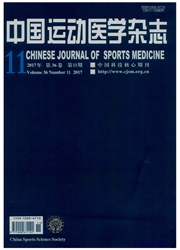

 中文摘要:
中文摘要:
目的:通过观察运动干预对帕金森病(Parkinson’s disease,PD)大鼠行为功能、纹状体中等棘状神经元(MSNs)树突棘密度及α-氨基-3-羟基-5-甲基-4-异恶唑丙酸(a-amino-3-hydroxy-5-methy1-4-isoxa-zolep-propionate,AMPA)受体亚基表达的影响,揭示运动改善PD行为功能障碍的相关机制。方法 :选用清洁级雄性SD大鼠,饲养1周后随机分为假手术安静组(Control组)、假手术运动组(Control+Ex组)、帕金森安静组(PD组)、帕金森运动组(PD+Ex组),每组14只。采用6-羟基多巴胺(6-OHDA)于内侧前脑束单点注射的方法建立PD大鼠模型,假手术组给予同等剂量生理盐水。术后24h对运动组大鼠进行4周运动干预,运动方案为11 m/min,30 min/day,5 days/week。大鼠在造模后第7、14和28天颈部皮下注射阿朴吗啡(APO)进行旋转行为测试评价模型可靠性,并结合圆桶试验评价PD大鼠行为功能。采用高尔基染色技术观察纹状体MSNs树突棘密度,免疫组织化学技术观察纹状体Glu R1和Glu R2表达变化。结果:第14天和第28天APO诱导的旋转行为能力检测结果:PD运动组旋转次数较PD组显著减少(P〈0.05)。圆桶试验结果:在侧前肢接触壁次数PD组(15.35±5.21%)较假手术安静组(49.82±8.41%)和PD运动组(26.24±6.96%)显著降低(P〈0.01),且PD运动组较PD组显著增加(P〈0.05)。高尔基染色结果:PD运动组大鼠纹状体MSNs树突棘密度较PD组明显增加(P〈0.05)。免疫组化结果:PD运动组大鼠纹状体Glu R2表达较PD组显著增加(P〈0.01)。结论:纹状体MSNs形态结构重塑可能是运动改善PD大鼠行为功能障碍的重要途径之一。运动调节纹状体AMPA亚基表达可能介导了这一过程。
 英文摘要:
英文摘要:
Objective To investigate the effects of exercise on the behavioral function in rats with Parkinson's disease. Method 56 clean grade male SD rats were randomly and equally divided into sham operation group (Control), sham operation plus exercise group (Control +Ex), Parkinson' s disease group (PD), Parkinson's disease plus exercise group (PD+Ex). The PD rat model was established by injection of 6- hydroxydopamine (6-OHDA) into the medial forebrain bundle single point. The rats in groups Control and Control+Ex received same dose of physiological saline injection. Rats in exercise group underwent 4-week exercise intervention ( 11 m/min, 30 rain/day, 5 days/week) 24 hours after operation. Apomorphine (APO) was subcutaneously injected to the rats in group PD in 7,14 and 28 days to conduct rotation behavior test. In addition, cylinder test were used for evaluation of behavioral function of rats. The dendritic spine density of medium spiny neurons (MSNs) in striatum was detected by Golgi staining,expression of striatal GluR1 and GluR2 subunits were tested by immunohistochemical technique. Result The number of rotation was significantly reduced in group PD+Ex as compared with group PD(P 〈 0.05). The frequency of wall contact of the left forelimb in group PD (15.35 ± 5.21%) decreased significantly as compared with group Control(49.82±8.41%)(P 〈 0.01) and group PD+Ex (P 〈 0.05). The dendritic spine density of striatal MSNs increased significantly in group PD+Ex as compared with group PD (P 〈 0.05),and striatal GluR2 expression increased significantly in group PD +Ex as compared with the group PD (P 〈 0.01 ). Conclusion Exercise induced remodeling of striatal MSNs morphology could be one of the important ways to improve the behavior of the movement dysfunction in PD rats.
 同期刊论文项目
同期刊论文项目
 同项目期刊论文
同项目期刊论文
 期刊信息
期刊信息
